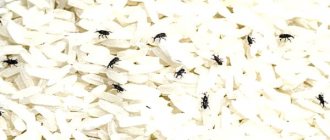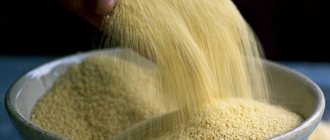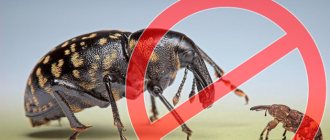Many housewives want to know how to get rid of bugs in cereals in the cupboard. The main reasons for the appearance of insects are improper organization of food storage, poor quality of raw materials or poor packaging. At the same time, some types of pests can spoil not only food, but also furniture, kitchen utensils, and towels.
Small bugs in cereals spoil the product and make it unfit for consumption. To get rid of the problem, it is necessary to eliminate its source, conduct an inventory audit and disinfect the premises
In this article, we have collected useful tips and recommendations that will help get rid of pests and also prevent their occurrence in the future.
Where do insects come from?
Pests can settle in bulk products for three reasons.
- Uncleanliness of the housewife. Unsanitary conditions in the kitchen are the least likely cause of “uninvited guests.” Even if you do general cleaning every day, you cannot be guaranteed to protect yourself from pests: insects can be brought into the house along with purchases from the store.
- Dishonesty of suppliers. Factories do not always comply with sanitary control requirements: storage conditions are often violated, and products do not undergo the necessary heat treatment. As a result, the housewife buys cereals that already contain pests.
- "Dangerous neighborhood." Insects can “immigrate” into cereals from nearby stocks of tea, herbs, pasta, dried fruits, and seasonings purchased by weight.
How do they get into the house?
You buy bugs. They don't start on their own and don't fly off the street. Typically, insects come with loose cereals, which are cheaper than packaged ones.
But they can also be in sealed packaging. Therefore, watch what you take. Although, to be fair, usually “sold” are larvae that cannot be seen.
What are these pests and how dangerous are they?
Let's get to know pests better and find out which bugs most often “settle” in dry cereals.
Small flour beetles
Reddish-brown long bugs (3-3.5 mm) with wings, short antennae and rounded sides. Pests like buckwheat, semolina, flour, dried fruits, and millet. Flour bugs need to be dealt with immediately: eating foods with insects can cause stomach disorders, poisoning, and allergic reactions.
Small beetles reproduce at an astonishing rate: pests produce up to four generations of offspring per year. Mealworms are the larvae of this pest.
Surinamese mucoeds
Red beetles with long mustaches, whose body has a saw-tooth shape and is lined with short silky hairs. The length of insects is 1.5-2.5 mm. Typically, mealworms find refuge in rotten flour, corn grits, and loose pet food. Bulk products with a moisture content of less than 15-17% are not afraid of such pests.
One of the characteristic signs of “infestation” with red pests is a sieve for sifting flour chewed to holes. Con, insects increase the humidity of the cereals, littering the reserves with excrement and shells of larvae.
Bread grinders
Brown or red-brown bugs are cylindrical in shape, 1.8-3.7 mm long, the body of which is covered with hairs. Pests are unpretentious when it comes to food. Cereals and grains, tea and coffee, dried herbs, crackers, cookies, pet food, nuts and dried fruits - voracious insects are not averse to eating all of this.
The waste products of grinders are hazardous to health. Even if you manage to remove the insects from their grains, eating the spoiled product is strictly contraindicated.
If the number of insects is small, you may not even notice their presence - they do not crawl out. But if the density of their “population” is high, waste products and dead insects are found in herbariums, book bindings, even on walls and window sills.
Rice weevils (elephants)
Dark brown or almost black beetles with underdeveloped wings, body length - up to 4 mm. Most often, the pest settles in pasta, rice, barley grains, millet and rye, and flour. The waste products of pests and larvae are toxic, therefore, if even one beetle is found in the products, they can no longer be eaten.
food moth
A gray moth, the body length can reach 1 cm. The moth part is found in dried herbs, cereals, sugar and flour. Food moths, feeding on food supplies, contaminate them with excrement and remains of shells.
When asked whether bugs in cereals are dangerous for humans, experts answer in the affirmative, so if insects are detected, you must immediately begin fighting them.
Chemical methods and store-bought products
Chemical methods can affect people's well-being, so strict adherence to safety precautions is necessary when using them. As a rule, the instructions for use contain information about the period during which you cannot enter the premises.
On a note!
The most commonly used are insecticides or chlorine and chlorine-containing products.
The store shelves have a huge assortment to suit every taste, color and budget. Here are the most popular options:
- Pyrethrum is considered one of the safest chemicals. It is made in the form of a powder, which is laid out in hidden places and near cereals. The substance is safe for people and animals, but it is better to exercise caution.
- Anti-bug is intended for treating flat surfaces in order to destroy and prevent the appearance of pests (black bugs, food moths). Hazardous to health if it enters human organs.
- Rogneda is another chemical that requires caution in use. It works not only on bugs, but also on many other pests. For example, cockroaches.
- Dichlorvos is a fast-acting aerosol. Effectively eliminates bugs without giving them a chance. Spray only using special protective equipment.
You can use Dust, Whiteness and other compounds. If the owner determines the type of beetle, then you can pick up the remedy in any specialized store.
How to get rid of bugs in cereals
It is worth removing beetles from cereals only if there are few insects. If pests have abundantly colonized bulk products, no traditional methods will help. Insects lay eggs in cereals, which are almost impossible to notice with the naked eye. There may also be colorless bugs - larvae - in the reserves.
However, even the elimination of contaminated food, judging by reviews, does not always guarantee freedom from unpleasant “neighbors.” But you can try by performing three consecutive steps.
- Screening. Armed with a sieve, sift the flour and carefully sort the cereal.
- Calcination. Calcine the product in an oven preheated to 100-110°C.
- Washing. Immediately before use, soak the cereal in a salt solution, then rinse thoroughly in running water.
There is only one way to effectively get rid of insects in cereals: throw away all products in which insects are found and carry out a thorough disinfestation.
Why you shouldn't eat contaminated foods
When food is infested with insects, continued consumption may be dangerous. If there were few bugs, then drying and sifting the cereal or flour will eliminate all problems with its quality. But, when the infection was significant, the bugs destroy large volumes of useful substances in the product, including proteins, and instead leave the remnants of their own vital activity:
- excrement;
- chitinous plates;
- cocoons from larvae.
The taste characteristics of such a product are significantly reduced, as is its usefulness for the body. Flour, after being infected by a flour eater, can completely lose its properties - the dough from such a product cannot be kneaded. A negative point is also the risk of food poisoning. It is preferable to throw away products that have been significantly damaged.
How to prevent uninvited “guests” from multiplying
Even if the parasites thrown out along with the cereals never return to the kitchen, some of the insects, having spread throughout the house, will continue to reproduce successfully. To completely eliminate pests, you need to act in three stages.
Inspection of stocks and sending to quarantine
Carefully check all food stored in the house for the presence of voracious insects. Throw away all supplies containing pests. Place cereals in which no traces of pests were found in the freezer for three to four days. After this period, you should carefully sort through the bulk products: if the bugs do not appear, they can be placed in jars for storage.
Washing containers
If cereals attacked by insects were stored in plastic or glass containers, the containers can be disinfected. At home, this can be done like this: soak for half an hour or longer in a strong soap solution, then rinse with running water and dry. It is best to replace the storage jars with new ones, after washing them with soda or laundry soap.
spring-cleaning
You can treat the cabinets to get rid of bugs in the cereal with a strong solution of laundry soap and soda. It wouldn’t hurt to wipe down the shelves, tables, window sills, floors, even the walls in the kitchen. After this, walk over the surfaces with a cloth moistened with a 9% vinegar solution (a tablespoon per liter of water). Pour boiling water over latches in cabinets, cracks in floors and walls.
It is advisable to clean the cabinets with a vacuum cleaner using a narrow attachment: this measure will help get rid of eggs, larvae and pest excrement. Particular attention should be paid to corners, cracks and doors.
Methods of combating the parasite
Small bugs in flour, cereals and other dry foods lead to many problems. The peak of their activity is observed in the summer season. When foreign dark inclusions are found in flour, cereals and the like, it is actually possible to say with complete confidence that these are flour eaters. Their detection indicates the need for a serious revision of stocks - this is the main stage of any technique that allows you to remove parasites. Without this step, none of the methods to completely get rid of mucous will give the expected results.
Attention! A period of activity and a rapid increase in the number of mucoed individuals can also occur in winter - when the temperature in a residential building or apartment is high.
The beginning of the fight against such pests is marked by the need to carry out a thorough cleaning of not only the kitchen, but also all other rooms in the apartment or house. At the same time, any products and other objects suitable for the parasite to live in (acorns, untreated wooden blocks, etc.), if the presence of a mucous beetle is suspected, must be thrown away. In the future, after getting rid of the parasite, to prevent it from returning, you need to perform regular cleaning and follow the rules for storing cereals.
Prevention: 6 rules of defense
The best remedy for bugs is prevention. By following six rules, you can protect your supplies from voracious pests.
- Use the “correct” storage containers. To prevent bugs from infesting cereals, you need to store cereals in tightly sealed glass jars or plastic containers.
- Process purchased products. Before storing cereals after purchase, they should be heated for 15 minutes in a preheated oven. This applies even to those bulk products that are packaged in vacuum bags. Another option is to put the cereal in the freezer for several days. These methods will help destroy the bugs in the cereal and prevent them from spreading throughout the house.
- Place garlic cloves or bay leaves in containers with cereals. A bay leaf or two or three garlic cloves in each jar of bulk products will help protect cereals from bugs. Fragrant “repellents” can also be placed on the shelves of kitchen cabinets.
- Store nuts and dried fruits in the refrigerator. Often, along with these products, especially those purchased in bulk, pests “arrive” in the house, so it is worth placing healthy goodies in the refrigerator.
- Don't turn your kitchen into a warehouse. A modern housewife can buy everything she needs at any time: there is no shortage of cereals in the near future. The fewer products are stored in cabinets, the less likely they are to become “infested” with insects, and the easier it is to get rid of pests if parasites do show up. Ideally, cereals should not be stored for more than two to four months.
- Maintain cleanliness. Regularly clean kitchen cabinets and cereal storage containers with a solution of 9% vinegar at least once or twice a month. If pests appear in the kitchen again and again, you should seek help from specialized organizations.
When thinking about how to remove bugs from cereals, you need to remember that eating foods that once contained insects is dangerous to health: eggs and larvae of pests can simply not be noticed. It is best to get rid of such stocks.
Video on the topic
What to do if a place of residence of bugs is discovered?
If you find a breeding ground for beetles somewhere, throw away the product. This is the best way, because even if you sift, there will be larvae in it, which will still turn into bugs. And then they will move on and occupy new territories.
We draw your attention to the fact that it is better to throw it away directly onto the street. Leave them in a trash can overnight - they will still scatter and at least one will be saved. And where there is one, there are, count, a hundred, in just a couple of weeks.
There is no need to flush it down the toilet, after all, this is a product, somehow it’s not according to Feng Shui. It’s better to take it to the trash container and the people who feed homeless animals will take the cereal.










